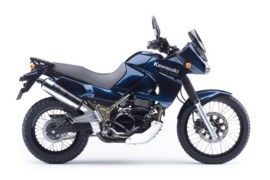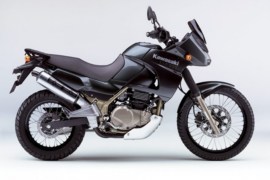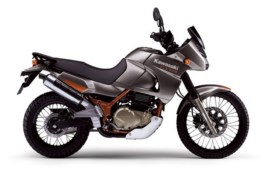KAWASAKI KLE 500 Models/Series Timeline, Specifications & Photos
First production year: 2004
In 2006, the Japanese motorcycle manufacturer launched the Kawasaki KLE 500, a dual sport machine that debuted in 1991 and continued production until 2007, when it was replaced by the Kawasaki Versys 650 (KLE 650).
In 2005, the bike was upgraded to pass the EURO2 emission regulations standards and featured a facelift that rejuvenated the range. Other modifications included a redesigned windscreen, removing the disc brake fairing, and changing the turn signals and instrument panel.
In the aesthetic department, the 2006 machine remained essentially unchanged, packing the same standard features as the previous model, including a front cowl with a small windscreen, a one-piece dual seat, a small luggage rack, an engine cover, a high-mounted exhaust system, and wire-spoke wheels.
The bike's backbone was a double cradle high tensile steel frame with a 41 mm telescopic fork on the front and a bottom-link uni-trak shock absorber on the rear, offering optimum handling capabilities.
The braking performance was handled by a 300 mm brake disc with a dual-piston caliper on the front wheel and a 230 mm disc with a single-piston caliper on the rear wheel, offering excellent stopping power.
As for the power figures, the 2006 Kawasaki KLE 500 had its soul brought to life by a 498cc four-stroke parallel-twin liquid-cooled engine that delivered 45 hp at 8,300 rpm and 41 Nm (30 lb-ft) torque at 7,500 rpm.
The Kawasaki KLE 500 was a dual sport motorcycle manufactured by Kawasaki from 1991 until 2007 when it was replaced by the Kawasaki Versys 650 (KLE 650). The bike handled both paved roads and light off-road trails.
In 2005, the Japanese motorcycle manufacturer launched the Kawasaki KLE 500, a dual sport machine with the same package as the previous model, packing the same visual, technical, and performance specifications without any modifications.
In the visual department, the bike remained unchanged from the previous model, packing standard features, such as a single headlight unit integrated into a small cowl, a small windscreen, a one-piece dual seat, a small luggage rack, a high-mounted exhaust system, and wire-spoke wheels.
In the performance department, the 2005 Kawasaki KLE 500 had installed a 498cc four-stroke parallel-twin liquid-cooled engine underneath its fuel tank, delivering 45 hp at 8,300 rpm and 41 Nm (30 lb-ft) torque at 7,500 rpm.
The bike's power was handled by a six-speed manual transmission with a wet multi-plate clutch, spinning the rear wheel to a top speed of 191 kph (118 mph) through a final chain drive.
From top speed to a complete stop, the bike relied on a 300 mm brake disc with a dual-piston caliper on the front wheel and a 230 mm brake disc with a single-piston caliper on the rear wheel, offering excellent stopping power.
The Kawasaki KLE500 was a dual-sports motorcycle manufactured by Kawasaki from 1991 until 2007 when it was replaced by the Kawasaki Versys 650 (KLE650). As a dual sports machine, it handled both paved roads and light off-road paths.
The bike featured an engine cover that protected the oil pan during off-road riding and a small windscreen that only slightly protected the shorter riders, leaving the torso and head exposed to the wind for taller riders.
In the visual department, the bike packed standard features, such as a single headlight unit in a small front cowl, a small windscreen, a one-piece dual seat with a small luggage rack, a high-mounted exhaust system, and lightweight wire-spoke wheels.
The 2004 Kawasaki KLE 500 had installed underneath its fuel tank a 498cc four-stroke parallel-twin liquid-cooled engine managed by two Keihin carburetors, delivering an output power of 45 hp at 8,300 rpm and 41 Nm (30 lb-ft) torque at 7,500 rpm.
The bike's engine was tied to a six-speed manual transmission with a wet multi-disc clutch linked to the rear wheel through a final chain drive, pushing the motorcycle to a top speed of 191 kph (118 mph).
From top speed to a complete stop, the bike relied on a 300 mm brake disc with a dual-piston caliper on the front wheel and a 230 mm brake disc with a single-piston caliper on the rear wheel, offering excellent stopping power.


